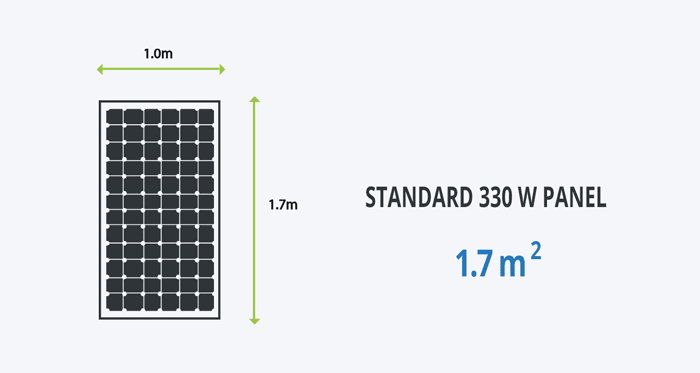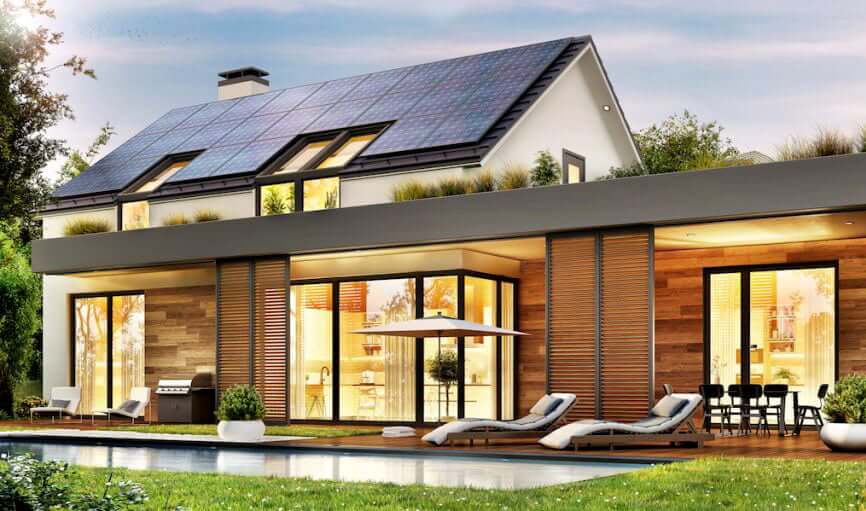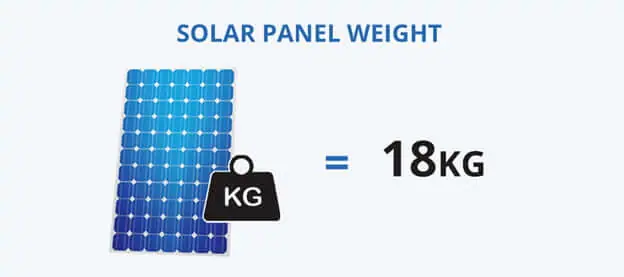Home Solar Panel Dimensions and Output and Weight
Solar panel dimensions and output
When thinking about installing solar panels on your rooftop, the size and efficiency of the panels will be key factors to consider.
Solar panels come in the standard 1.70m x 1.0m dimensions with an output ranging between 250 – 440 watts.
While output varies, in most cases the size of the single solar panel will not change.

Table of Contents
ToggleSolar panel sizes and wattage
There are three things referenced when talking about a solar panel or system size:
- The physical size of the solar panel
- The size in Watts or output of the solar panels
- The combined output of a solar system in Kilowatts
Above, you can see we have referenced the physical size of solar panels, but the other factor is output and efficiency.
Panel Output – The mean panel conversion efficiency has risen from 15% to 23%.1 Also the output size of a single solar panel ranges from 250W to 440W1. Whats the difference? Basically the 440W panel is more efficient and better quality than the older technology 250W panel. You can still use 250W panels, but you will need more of them to produce the same about of power.
6kW system = 24 x 250W solar panels or…
6kW system = 14 x 440W solar panels
System output – We normally work backwards from the desired output required to service your power needs. If, on average you consume 24kW of power per day (very common amount but check your power bill) you will need a 6kW solar system. It is also due to the factor that, on average, a 6kW solar PV system generates approximately 8,760 kWh of energy annually, based on an assumption of five hours of peak sunlight per day. This is adequate to supply power to various homes.
From the example, you can see that you can use different panel outputs to get this system’s output. However, you might need more or fewer panels depending on the brand you choose.
Roof space is a main deciding factor. If you have little north facing roof space, then you are best going with 460W panels as you will need less square meters to make up the 6kW system.
How many solar panels will I need?
The number of solar panels you need for your home depends on your daily energy consumption needs and your solar system size. The bigger your solar system is, the more solar panels you’ll need.
However, you won’t need many solar panels if you don’t have many consumers in the house.
| System size | No. of panels | m2 roof space required |
|---|---|---|
| 1.5kW | 5 | 9 m2 |
| 2kW | 6 | 10.3 m2 |
| 3kW | 9 | 15.4 m2 |
| 4kW | 12 | 20.4 m2 |
| 5kW | 15 | 25.5 m2 |
| 6.6kW | 20 | 34 m2 |
| 10kW | 30 | 51 m2 |
The panel’s power rating also determines the number of panels you’ll use. The higher your panel’s power rating, the fewer panels you’ll need to meet your home’s power demands.
Number of solar panels x output = Solar system size
Example: 20 x 330W panels = 6,600 W or 6.6kW solar system

What’s the size of a 250W solar panel?
The size of solar varies depending on the manufacturer. However, the standard size for a 250W solar panel is 1.6m x 1.0m.2 This is approximately 1.6 square meters.
When looking to install these panels in your home, you’ll need multiple panels to meet your power demands. A 250W panel means that the maximum power output of the panel is 250W.
Therefore, you’ll need 4-5 panels to generate 1kW or 1000W of energy. The more energy you need to offset in your home, the more solar panels you’ll need.
For a typical Australian home, you may need around 20 250W-solar panels to generate enough electricity. This will cost you 32 square meters of your roof.
Is a 320W solar panel physically bigger?
Not necessarily. Some manufacturers have designed the same 60-cell solar panel with much higher efficiency, 330W compared to the older 250W panels. This way, assuming you’re looking to install a 5kW system, you’ll need about 15 x 330-watt solar panels for your home instead of 20 x 250-watt panels.
How much roof space will I need for a 6kW system?
For your 6kW solar system, you’ll need about 20 c 330W solar panels. With the standard solar panel measuring 1.7m x 1.0m, you’ll need between 34m2 – of roof space to fit the entire system.
Keep in mind; the solar panels need to be a few inches from the edges of the roof, so the space needed might be a bit larger. Use an estimation of +/-5 square meters on your roof space calculations.
If you have limited roof space, you need to seek out panels with a higher output like a Solar Panel 400W PERC Monocrystalline ERA. With 400W output, you will only need 16 Panels and 28m2 of roof space.

What determines the size and output of a solar panel?
There are two main factors that determine the size and output of the solar panels:
- Solar cell materials
- Number of solar cells
Solar cell materials
With solar cell material, a solar panel may be made from:
- monocrystalline silicon,
- polycrystalline silicon,
- Thin-film solar substrates.
Generally, monocrystalline panels are the most efficient panels, so, they don’t need to be huge dimension-wise. They offer the best watts per square meter.
Polycrystalline panels are usually less efficient and thus require extra space to achieve a defined output goal. Its watt per square meter is low, and so, its dimension has to be big.
Solar panels made from other substrates such as Cadmium Telluride have the worst watts per square meter ratio. They are, therefore, quite large in physical dimensions, to accommodate the required output.
Number of solar cells per panel
With regards to the number of solar cells, solar panels are categorized into two:
- 60-cell solar panels
- 72-cell solar panels
The 60-cell solar panels are usually arranged in a 6 x 10 configuration, while the 72-cell come in a 6 x 12 setup. This means that the 72-cell panel is a bit taller than the 60-cell solar panel by a few inches.
The extra space on the 72-cell solar panel is caused by the additional photovoltaic cells in the panel. This gives it the potential to generate a higher power output compared to the 60-cell solar panels. It’s also the reason why most residential homes use 60-cell solar panels while commercial buildings use 72-cell panels.
However, having 72-cell solar panels won’t always guarantee you higher power output. Some panels have more photovoltaic cells, but their output is still lower. For instance, a 72-cell solar panel with a power rating of 300W is less effective than a 60-cell solar panel with a power rating of 325W.
Your available roof space also determines the size and output of the panels you can install.
If your home has a large roof space or some open land for solar installation, 72-cell solar panels will be ideal. However, if you have a smaller space, 60-cell panels will be more effective.
To achieve the highest power output, you’ll have to go for the solar panels with more photovoltaic cells and high efficiency, e.g., 72-cell solar panels with a 400W power rating.
How much do solar panels weigh?

On average, standard solar panels weighs 18KG. The weight varies sightly depending on the brand’s manufacturer. Any roof in good condition can handle this weight. However, if your roof is a bit old, it’s wise to inspect your roof and do the necessary repairs before completing the installation.
What is the output of a standard solar panel?
There are numerous factors that affect a solar panel’s output, it’s hard to clearly determine the output of a standard solar panel.
However, most Australian homes record about 1-1.5kWh daily from their solar panels. This output depends on the power rating of the solar panel.
To calculate a solar panel’s output, all you need is its power rating and the total number of sunlight hours in your area. Here’s the formula:
Solar panel output = Solar panel power rating x Sunlight hours in your area.
And since different states in Australia receive varying sunlight hours, each panel’s output will vary by location. The more daylight hours the panel receives, the more power it will generate.
Considering you have a 300W solar panel with an average of 4 sunlight hours, its output for the day will be 300 x 4 = 1200w or 1.2kWh. Monthly, this system produces 36kWh, and annually, that’s 432kWh.
Nevertheless, you have to ensure that the solar panel is protected from shading of any form, and it’s titled facing North to receive direct sunlight. Otherwise, the panel’s output will be a bit lower even on very sunny days.
Specifications of a 300-watt solar panel
The 300W Sundragon premium-grade solar panel is among the most efficient panels on the market. It’s a polycrystalline Silicon made from Invensun, designed under the strictest quality standards.
The panel is composed of 72 photovoltaic cells, each measuring 156mm by 156mm. Its frame is made using Anodized Aluminum alloy with a 6bypass diode system in place.
It weighs 23kg and measures 1956 x 992 x 50mm. The panel also operates under 37.50V and 7.99A with a power tolerance of +/-5%.
With such powerful features, the applications of this solar panel are endless – from pumping water irrigation systems to powering emergency communication systems, railroad signals, recreational vehicles, aviation obstruction lights, and navigation lighthouses, among other uses.
The panel serves as an excellent long-term investment as it comes with a 5-year product warranty, 90% output after ten years in operation, and only 80% output after 25 years.
Are solar panels a standard size?
Mostly yes. Despite manufacturers using different measurements for their brands, the length and width of solar panels only differ slightly from the standard 1.7m by 1.0m size.
Table of Contents
Toggle




